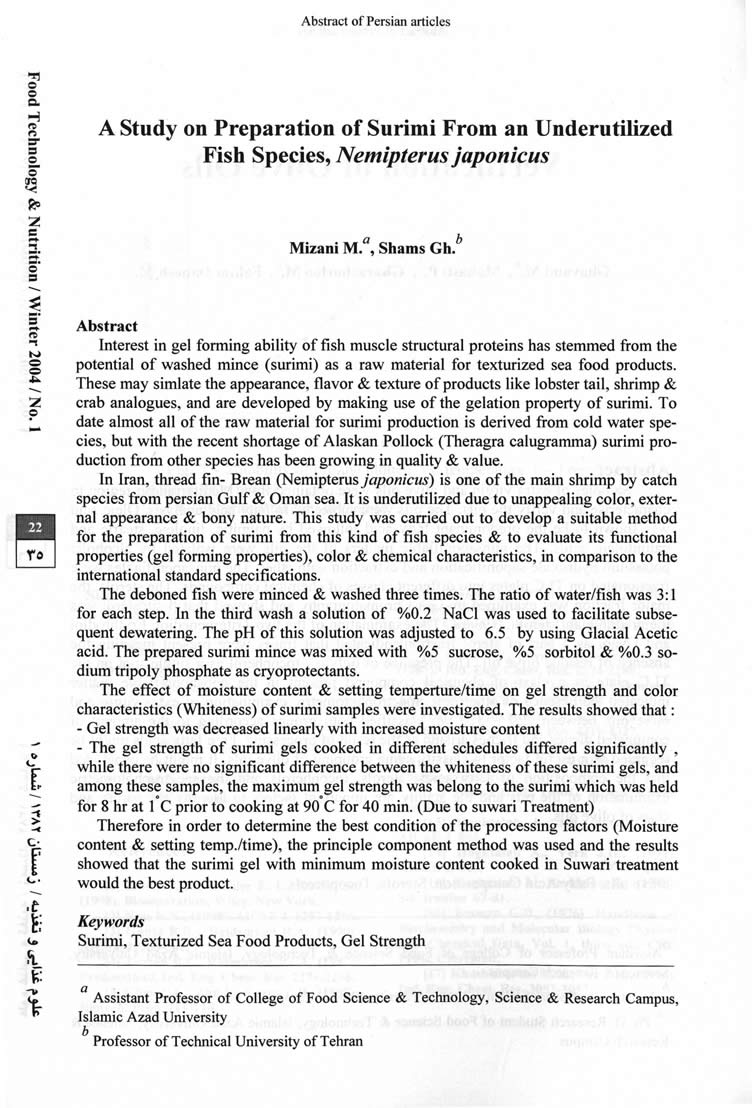 A Study on Preparation of Surimi from an Underutilized Fish Species, Nemipterus japonicus
A Study on Preparation of Surimi from an Underutilized Fish Species, Nemipterus japonicusMizani, M; Shams, Gh; 2004; A Study on Preparation of Surimi from an Underutilized Fish Species, Nemipterus japonicus; Food Technology & Nutrition, Vol. 1, No. 1, 10-18.
Abstract: Interest in gel forming ability of fish muscle structural proteins has stemmed from the potential of washed mince (Surimi) as a raw material for texturized seafood products. These may simulate the appearance, flavour and texture of products like lobster tail, shrimp and crab analogues, and are developed by making use of the gelation property of Surimi. To date almost all of the raw material for Surimi production is derived from cold water species, but with the recent shortage of Alaska Pollack (Theragra calugramma) Surimi production from other species has been growing in quality and value. In Iran Thread fin-Bream ( Nemipterus japonicus) is one of the main shrimp by catch species from Persian Gulf and Oman sea. It is underutilized due to unappealing colour, external appearance and bony nature. This study was carried out to develop a suitable method for the preparation from this kind of fish species and to evaluate its functional properties (gel forming properties), colour and chemical characteristics, in comparison to the international standard specifications. The deboned fish were minced and washed three times. The water/fish mince ratio was 3:1 for each step. In the third wash a solution of 0.2% NaCl was used to facilitate subsequent dewatering. The pH of this solution was adjusted to 6.5 by using glacial acetic acid. The prepared surimi mince was mixed with 5% sucrose, 5% sorbitol and 0.3% sodium tripolyphosphate as cryoprotectant. Effect of final moisture content and condition of washing steps(time, temperature) on gel strength and colour (whiteness) of surimi samples were investigated . The results showed:
- Gel strength was decreased linearly with increasing of moisture content.
- Gel strength of surimi gels cooked in different schedules differed significantly, while there were no significant differences between the whiteness of these surimi gels. The surimi held for 8 hrs at 1ºC prior to cooking at 90ºC for 40 min showed maximum gel strength (due to suwari treatment).
Keywords: Surimi, Texturized Seafood Products, Gel Strength
Visit: 4901
Abstract: Interest in gel forming ability of fish muscle structural proteins has stemmed from the potential of washed mince (Surimi) as a raw material for texturized seafood products. These may simulate the appearance, flavour and texture of products like lobster tail, shrimp and crab analogues, and are developed by making use of the gelation property of Surimi. To date almost all of the raw material for Surimi production is derived from cold water species, but with the recent shortage of Alaska Pollack (Theragra calugramma) Surimi production from other species has been growing in quality and value. In Iran Thread fin-Bream ( Nemipterus japonicus) is one of the main shrimp by catch species from Persian Gulf and Oman sea. It is underutilized due to unappealing colour, external appearance and bony nature. This study was carried out to develop a suitable method for the preparation from this kind of fish species and to evaluate its functional properties (gel forming properties), colour and chemical characteristics, in comparison to the international standard specifications. The deboned fish were minced and washed three times. The water/fish mince ratio was 3:1 for each step. In the third wash a solution of 0.2% NaCl was used to facilitate subsequent dewatering. The pH of this solution was adjusted to 6.5 by using glacial acetic acid. The prepared surimi mince was mixed with 5% sucrose, 5% sorbitol and 0.3% sodium tripolyphosphate as cryoprotectant. Effect of final moisture content and condition of washing steps(time, temperature) on gel strength and colour (whiteness) of surimi samples were investigated . The results showed:
- Gel strength was decreased linearly with increasing of moisture content.
- Gel strength of surimi gels cooked in different schedules differed significantly, while there were no significant differences between the whiteness of these surimi gels. The surimi held for 8 hrs at 1ºC prior to cooking at 90ºC for 40 min showed maximum gel strength (due to suwari treatment).
Keywords: Surimi, Texturized Seafood Products, Gel Strength
Visit: 4901
design by: webcandy.ir
